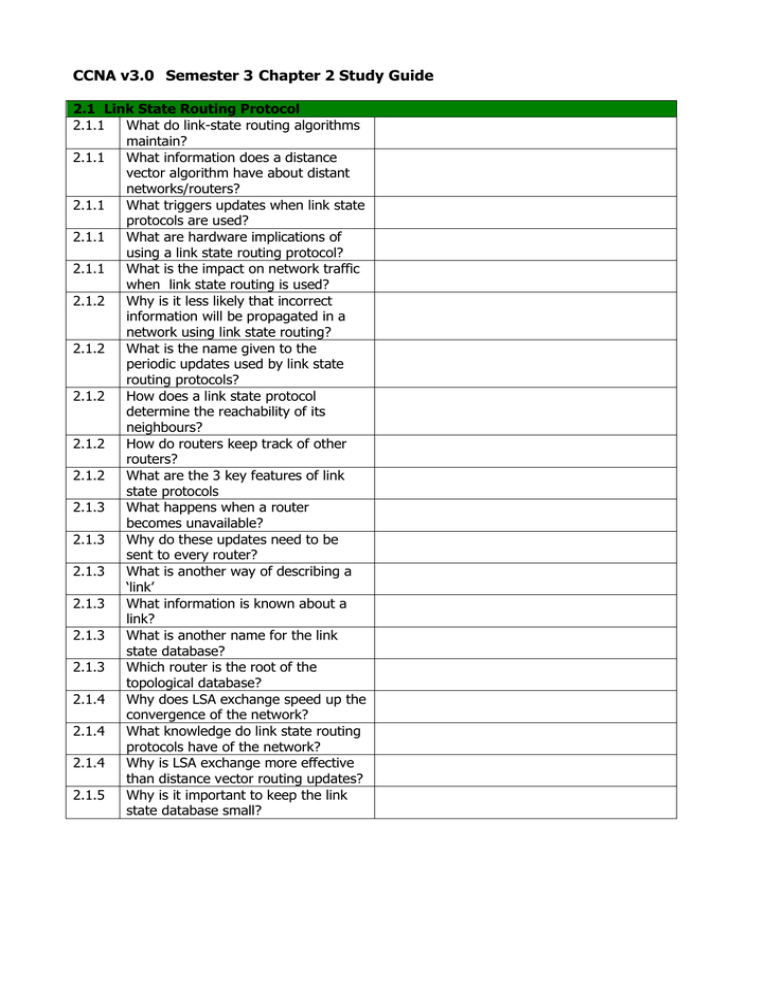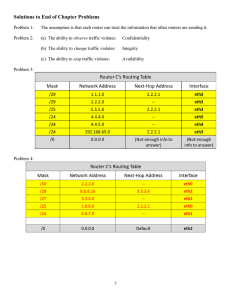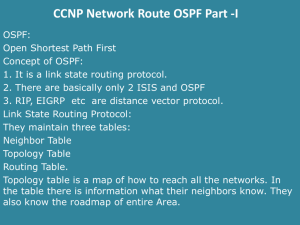CCNA v3.0 Semester 3 Chapter 2 Study Guide
advertisement

CCNA v3.0 Semester 3 Chapter 2 Study Guide 2.1 Link State Routing Protocol 2.1.1 What do link-state routing algorithms maintain? 2.1.1 What information does a distance vector algorithm have about distant networks/routers? 2.1.1 What triggers updates when link state protocols are used? 2.1.1 What are hardware implications of using a link state routing protocol? 2.1.1 What is the impact on network traffic when link state routing is used? 2.1.2 Why is it less likely that incorrect information will be propagated in a network using link state routing? 2.1.2 What is the name given to the periodic updates used by link state routing protocols? 2.1.2 How does a link state protocol determine the reachability of its neighbours? 2.1.2 How do routers keep track of other routers? 2.1.2 What are the 3 key features of link state protocols 2.1.3 What happens when a router becomes unavailable? 2.1.3 Why do these updates need to be sent to every router? 2.1.3 What is another way of describing a ‘link’ 2.1.3 What information is known about a link? 2.1.3 What is another name for the link state database? 2.1.3 Which router is the root of the topological database? 2.1.4 Why does LSA exchange speed up the convergence of the network? 2.1.4 What knowledge do link state routing protocols have of the network? 2.1.4 Why is LSA exchange more effective than distance vector routing updates? 2.1.5 Why is it important to keep the link state database small? 2.2 Single Area OSPF Concepts 2.2.1 What is RFC 2328? 2.2.1 Why Is OSPF preferred to RIP v1 and v2? 2.2.1 How are large OSPF networks designed 2.2.1 What is the advantage of a hierarchical design? 2.2.2 Which router port does NOT flood information onto the network? 2.2.2 What do routers in the same OSPF area have in common? 2.2.2 What do OSPF routers to with the information in the link state database? 2.2.2 What is the adjacency database? 2.2.2 What are the DR and BDR? What is their purpose? 2.2.3 What types of networks are suited to OSPF? 2.2.3 Why are OSPF routing updates more efficient? 2.2.4 What is the purpose of the SPF algorithm? 2.2.5 What type of networks are recognised by OSPF? 2.2.5 What problem is solved by a Designated Router? 2.2.5 What is the address is used by the DR to send link state information? 2.2.5 What is the disadvantage of a DR. How is this problem solved? 2.2.5 What address is used by the BDR to send link state information? 2.2.5 Why are DR and BDR unnecessary on point to point networks? 2.2.6 What happens when a router starts the OSFP routing process? 2.2.7 What is the address of a hello packet 2.2.6 What is the purpose of hello packets? 2.2.6 How often are hello packets sent? 2.2.6 What happens when hello packets are sent on multi access networks? 2.2.7 What are the steps in link state operation? 2.3 Single Area OSPF Concepts 2.3.1 What numbers can be assigned to OSPF areas? 2.3.1 What is area 0? 2.3.1 What is another name for Area 0? 2.3.1 What is used instead of a subnet mask when configuring area information? 2.3.1 What is the command to enable OSPF routing? 2.3.1 What is the process ID? Router(config)# router ospf 1 2.3.1 Router(config-router)#network 192.168.9.0 0.0.0.255 area 2 2.3.2 2.3.2 2.3.2 2.3.2 2.3.2 2.3.2 2.3.2 2.3.2 2.3.3 2.3.3. 2.3.3 2.3.3 2.3.4 2.3.4 2.3.4 2.3.4 Explain in as much detail as possible what the IOS commands above describe. What is the router ID used by an OSPF router? Why is a loopback interface designated on OSPF routers? What is the command used to create and assign an IP address to a loopback interface? What is the subnet mask of a loopback interface What is the OSPF priority? Explain is purpose in electing a DR/BDR What is OSPF priority 0? What happens with routers have the same priority? What is the command to configure OSPF priority? What command is used to display OSPF priority information? What is the default bandwidth for Cisco serial interfaces How is OSFP cost calculated? Why might it be important to change OSPF cost in a gigabit Ethernet environment. Which IOS command allows you to set the link cost? What is the length of an OSPF password? Which command configures OSPF authentication What is the disadvantage of this simple OSPF authentication? Which command configures OSPF key encryption on an interfacer? Router(config-if)#ip ospf authentication-key password Router(config-router)area area-number authentication The password is sent in plain text 2.3.4 2.3.4 2.3.4 2.3.4 2.3.5 2.3.5 2.3.5 2.3.5 2.3.5 2.3.6 2.3.6 2.3.6 2.3.7 How long is the encrypted key? What values can be used by the keyid What must routers in the same area have in common when OSPF authentication is used? Which command is used to encrypt the key using MD5 authentication? What is an OSPF dead value What is the default hello interval? Why might a network administrator change the hello interval? What is an important consideration when configuring timer intervals? Which command configures the hello interval? Why is a default route used in OSPF networks? Which command configures a default route What command is used to propagate this default route to all routers in the OSPF area? Why might neighbour relationships not be formed successfully between routers?







